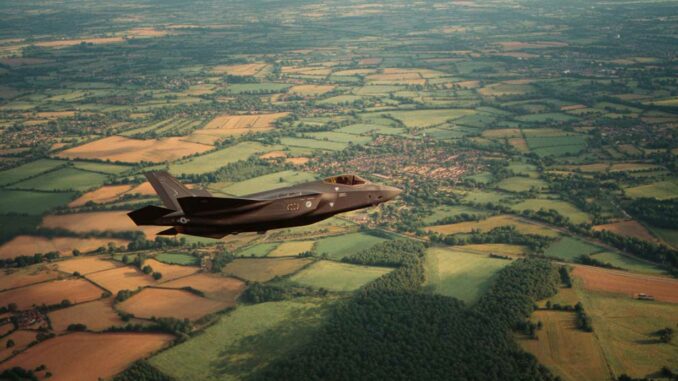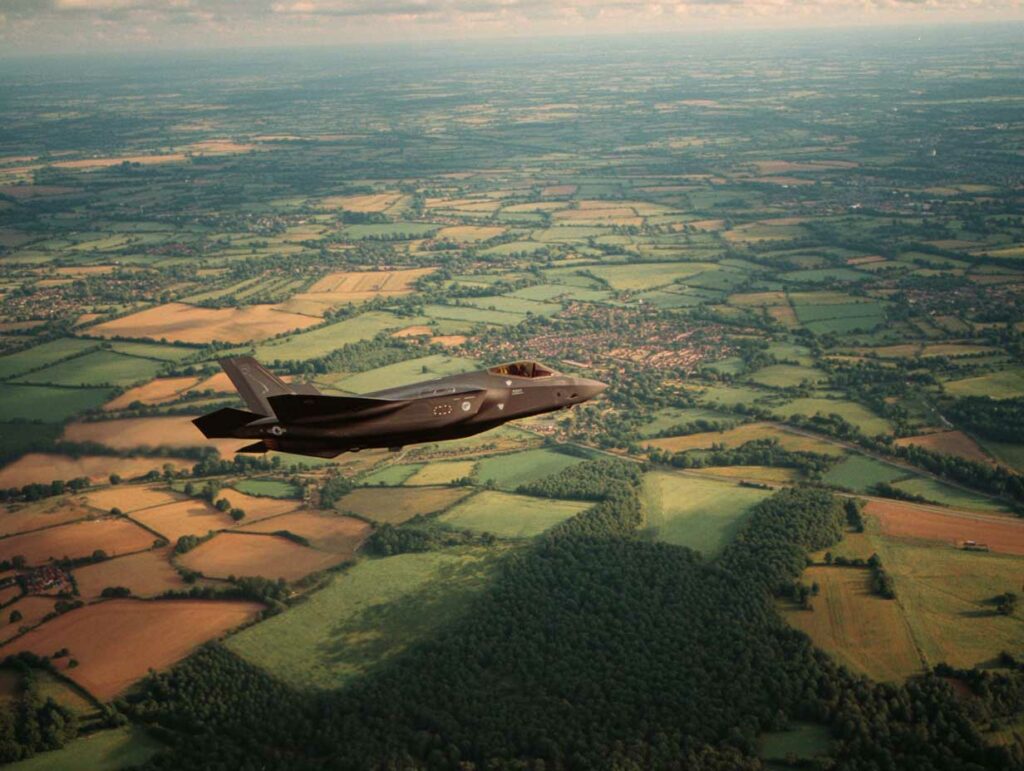
The United States reinstalled B61 nuclear bombs at RAF Lakenheath in July 2025. This decision reintroduces an airborne nuclear capability in Britain and strengthens NATO’s deterrence against Russia.
In summary
In July 2025, US B61-12 nuclear bombs were quietly redeployed to RAF Lakenheath in eastern England. This is the first confirmed or highly probable presence of US nuclear weapons on British soil since 2008. This base is now home to the US Air Force’s 48th Fighter Wing, which operates F-15E Strike Eagles and F-35A Lightning IIs, two types of aircraft qualified to carry and deploy the B61. This return changes the architecture of NATO’s tactical nuclear deterrence in Europe. It brings American nuclear weapons closer to the European theater, within direct range of Russian territory, and sends a strategic message: the Atlantic Alliance is prepared to use so-called “non-strategic” nuclear force in the event of a major escalation. London is once again taking an active role in the shared nuclear mission, while Russia is stepping up its military pressure on NATO’s eastern border.
The physical return of American bombs to British soil
The presence of American nuclear weapons at RAF Lakenheath ceased in 2008, after the end of the Cold War and the perceived threat had diminished. The United States had gradually dismantled the operational infrastructure on site. In the early 2000s, the base still had 33 underground storage vaults (Weapons Storage and Security System) capable of housing up to 110 B61-type nuclear bombs ready for transport by the F-15Es of the 48th Fighter Wing. Open sources indicate that in July 2025, several B61-12 bombs were transferred from Kirtland Air Force Base in New Mexico, home to the US Air Force’s nuclear center, to Lakenheath. C-17 Globemaster III flights were tracked between the United States and the United Kingdom around July 15-25, 2025, with no return flights identified. The US and UK authorities are applying the classic “neither confirm nor deny” rule. But the evidence points in one direction: renovation of hardened shelters, creation of “surety” facilities (nuclear security and physical control), enhanced security procedures, and explicit reactivation of the nuclear mission within the 48th Fighter Wing.
For the United Kingdom, this is a major change. The country had not officially hosted US nuclear weapons for nearly 17 years. The return of B61-12 gravity bombs to its territory puts the United Kingdom back at the heart of NATO’s tactical nuclear deterrence.
RAF Lakenheath, NATO’s forward nuclear pivot
RAF Lakenheath is a US base operated in the United Kingdom, located in Suffolk, about 110 kilometers northeast of London. It is home to the US Air Force’s 48th Fighter Wing. This unit is unique within USAFE (United States Air Forces in Europe) for one simple reason: it fields both F-15E Strike Eagles and F-35A Lightning IIs.
The F-15E Strike Eagle remains a long-range, two-seat attack platform capable of delivering a B61 nuclear payload at low altitude and high speed. This aircraft, which entered service in the late 1980s, is still considered one of the most credible tactical nuclear delivery systems in the US Air Force in Europe.
The F-35A Lightning IIs of the 495th Fighter Squadron, reactivated in 2021 at Lakenheath, bring something else to the table: stealth capability. The F-35A was certified to carry the B61-12 in 2023, making it the first fifth-generation stealth fighter qualified for tactical nuclear missions. Its low radar signature, sensor fusion, and ability to penetrate modern air defense bubbles make it relevant against the advanced surface-to-air systems deployed by Russia.
The fact that these two vectors—the F-15E and F-35A—operate from the same base, within direct range of NATO’s eastern flank, makes RAF Lakenheath unique. This combination exists nowhere else in Europe. It sends a clear military message to Moscow: NATO has a flexible airborne nuclear strike capability already in the European theater, with no strategic delay.
The B61-12 weapon, a modular tactical nuclear tool
The B61 bomb is a gravity-based nuclear weapon that entered service in the 1960s and has been continuously modernized. The B61-12 version is now the standard iteration known as “tactical” or “selective low yield.” It is equipped with a guidance kit that improves its accuracy and an adjustable yield (“dial-a-yield”) ranging from a few kilotons to several dozen kilotons. For comparison, the Hiroshima bomb was about 15 kilotons.
The military advantage is obvious: a more accurate weapon can, in theory, use a lower yield while remaining credible against a hardened military target (command post, armored concentration, logistics hub). This fuels a strategic debate: by improving accuracy and offering lower yields, nuclear weapons become more “usable” in a scenario of limited regional escalation.
NATO’s nuclear doctrine provides for the possible use of so-called non-strategic weapons—i.e., those with a shorter range and lower yield than intercontinental ballistic missiles—to stop a major conventional offensive. In short, if a mechanized force backed by Moscow crosses a NATO border en masse, the Alliance wants to retain the ability to threaten a targeted nuclear strike to force it to stop. This logic already existed during the Cold War. It is being reaffirmed today.
The return of the B61-12 to the United Kingdom expands the geographical coverage of these weapons in Europe. It is estimated that around 125 to 130 B61 bombs are already pre-positioned in continental Europe as part of NATO’s nuclear sharing, notably in Germany, Italy, Belgium, the Netherlands, and Turkey. Lakenheath becomes an additional point on the map, west of the North Sea, around 2,000 kilometers from Russia’s westernmost borders.

The political dimension for London and Washington
The United Kingdom already has its own strategic deterrent system: Vanguard-class nuclear-powered ballistic missile submarines armed with Trident II D5 ballistic missiles. This force is designed to destroy strategic targets at long range. It is calibrated for national survival.
The return of US nuclear weapons changes the equation. London has agreed to once again become a forward platform for the US nuclear arsenal, directly benefiting NATO. This reintroduces an airborne nuclear capability on British territory, which had disappeared since the withdrawal of the British WE-177 bomb in 1998.
The British government has also approved the purchase of an initial batch of 12 additional F-35As, explicitly capable of carrying the B61-12. This purchase represents an announced unit cost of around £75-80 million per aircraft, or approximately €86-92 million, and is part of a broader effort to increase defense spending. London’s stated objective is clear: to strengthen the credibility of NATO’s nuclear deterrent and show that the United Kingdom is not only a Trident carrier at sea but also a player in the Alliance’s shared nuclear mission.
Politically, this return comes at a time when Russia is engaging in aggressive nuclear rhetoric and has itself transferred so-called “tactical” nuclear weapons to Belarusian territory. The Russian authorities denounce the American presence at Lakenheath as an escalation. Western capitals respond that it is a direct response to this pressure and to the level of threat following the invasion of Ukraine.
NATO’s military logic behind Lakenheath
This deployment responds to three operational imperatives.
First imperative: responsiveness. Having B61-12s already stored within range of the European theater reduces ramp-up times. Aircraft based at Lakenheath can take off armed from the UK, without last-minute weapons transfers from the US.
Second imperative: redundancy. Until now, most of NATO’s airborne nuclear mission has relied on forces based in continental Europe, notably F-16s and Tornados, which are currently being phased out. The F-35As are gradually taking over. With Lakenheath, the Alliance is acquiring an additional base outside continental Europe, making it less vulnerable to a first conventional or hybrid strike against continental sites.
Third imperative: credibility. The F-35As at Lakenheath offer stealth penetration capabilities against modern Russian surface-to-air defenses (S-400, S-500) . The F-15Es provide strike volume, range, and payload capacity. The two platforms can operate together in a mixed package. This combined effect increases the probability that the weapon will actually reach its target. In other words, NATO’s nuclear deterrence is not based solely on a political declaration, but on a measurable technical capability.
The gray areas that remain
Several areas remain deliberately vague. Washington and London strictly enforce the policy of nuclear secrecy: no confirmation, no official count, no operational commentary. Analysts estimate that there are between 20 and 30 B61-12 bombs at Lakenheath. The exact number remains classified.
Another open question is the precise role of the Royal Air Force. Officially, the bombs remain under US control. But London has announced the purchase of F-35A aircraft, the conventional take-off version (rather than the F-35B short take-off version already in service on British aircraft carriers). The F-35A is the nuclear-certified version. This means that the United Kingdom is preparing to eventually resume its role as a “Dual Capable Aircraft” country, i.e., a NATO country whose national aircraft can carry American nuclear weapons under a double political lock (agreement of the American president and the British prime minister).
Finally, military credibility has a domestic political price. Voices in the UK are calling for a parliamentary debate on the return of US nuclear weapons to within 120 kilometers of Cambridge, in a densely populated area. Opponents warn of the risk of eastern England becoming a priority target in the event of a major escalation between NATO and Russia.
This advanced nuclear rearmament in the United Kingdom reflects a strategic reality: NATO is once again promoting the tactical nuclear option, and is now doing so with modern, stealthy capabilities based on British territory. Deterrence is once again visible, tangible, and pre-positioned, less than three hours’ flight from the Alliance’s eastern front.
Sources
– Federation of American Scientists, analyses on nuclear modernization at RAF Lakenheath, 2022-2025.
– US Air Force / 48th Fighter Wing, public data on the F-15E Strike Eagle and F-35A Lightning II, 2021-2025.
– OSINT observations of C-17 flights between Kirtland AFB (New Mexico) and RAF Lakenheath, mid-July 2025.
– British government statements on the acquisition of 12 F-35As and participation in NATO’s nuclear mission, June-July 2025.
– NATO public estimates of the B61 arsenal in Europe (approximately 125 to 130 tactical bombs), 2024-2025.
War Wings Daily is an independant magazine.